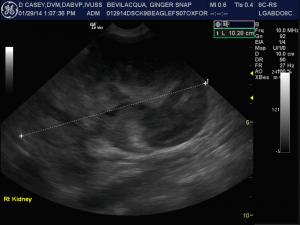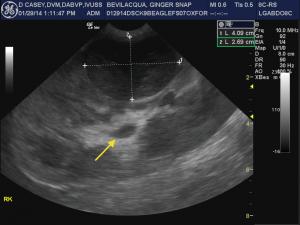Clinical Differential Diagnosis
Renal, chronic kidney disease, pyelonephritis, neoplasia. Hypercalcemia, neoplasia, granulomatous desease, hyperparathyroidism, renal disease. Polycythemia, vera, secondary (pulmonary disease, erythropoietin producing tumor).
Image Interpretation
The right kidney in this patient presented a mixed, hypoechoic mass that measured 10.4 x 8.08 cm with hyperechoic surrounding fat. The right kidney was completely infiltrated with a separate mass that measured 4 x 2.69 cm. Pyelectasia was noted in the right kidney and measured 1.08 cm. The right kidney measured 10.28 cm. Complete disruption of the corticomedullary junction and renal pelvis was noted. The left kidney was also enlarged with mild degenerative changes and pyelectasia that measured 0.5 x 1.5 cm. The left kidney measured 5.11 cm.
Sonographic Differential Diagnosis
Renal neoplasia. Given the polycythemia suspect erythropoietin secreting tumor. Renal lymphoma or other round cell neoplasia possible.
Sampling
US-guided FNA revealed renal lymphoma.
Outcome
Ultrasound-guided FNA revealed renal lymphoma The patient was somewhat stable on CCNU and prednisone therapy months after diagnosis of renal lymphoma.
Erythropoietin levels were not taken in this patient however EPO hypersecretion was suspected given the clinical presentation.




Comments